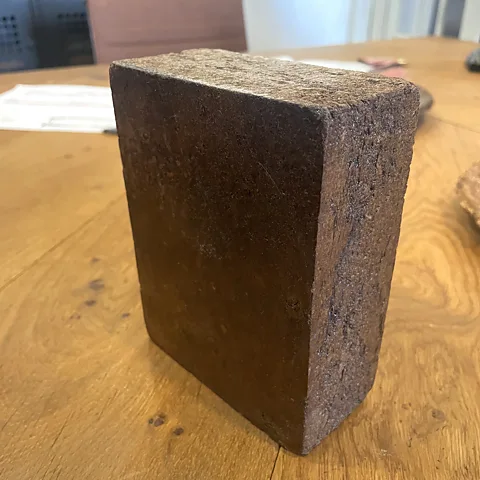In Cleveland, mushrooms digest entire houses: How fungi can be used to clean up pollution Monday, 18 March 2024

In the struggle to combat pollution and fight climate change, a growing number of scientists are beginning to look to one of nature’s oldest biotechnologies: fungi.
The city of Cleveland faces an epidemic of abandoned houses. Crumbling homes number in the thousands. These ramshackle structures are riddled with toxins like lead and dilapidated to the point of no return. And if tearing down and safely disposing of the waste of one such home sounds daunting, imagine thousands of them.
Among the numerous issues that arise, one essential question involves waste. What do you do with the waste material from so many teardown structures, when so much of it is toxic?
"All of the material from demolition – the studs, the floors, cellulosic mass [the primary structural component of plants], and even things like ceiling tiles and asphalt material like roof shingles, can be mixed into substrate that then becomes good for growing fungus," says Chris Maurer, founder of Cleveland-based architect firm Redhouse Studio. Through his firm, Maurer has been advocating for the use of substrate to address Cleveland’s housing crisis, which is also a health crisis for the city’s inhabitants.
 redhouse studio
redhouse studio
One of Cleveland’s numerous dilapidated houses (Credit: redhouse studio)
Substrate is any material that mycelium – the thready, vegetative part of fungi – uses for nourishment. In other words, fungi can eat the noxious waste from the abandoned homes. Heavy metals and other toxins are extracted and captured in the mushrooms that grow, while the substrate leftovers, including the mycelium, are compacted and heated to create clean bricks for new construction. The resulting "mycoblocks" have a consistency akin to hardwood and, depending on the specifics of the manufacturing process, have been shown to be significantly stronger than concrete.
This is Redhouse’s Biocycler program, which is one of many diverse efforts around the world aiming to eliminate pollution, combat climate change, and mitigate its already-looming effects via one of nature’s oldest biotechnologies: fungi.
"Effectively what we’re doing is diverting tonnage from landfill," says Joanne Rodriguez, founder and chief executive of a similar organisation called Mycocycle, which works to recycle construction waste for corporate clients. "[Because] 11% of the world’s carbon comes from materials in the built environment. By 2027, just from Mycocyle’s waste diversion, Rodriguez anticipates carbon reductions "of close to 160,000 metric tons."
What else can mushrooms do?
While digesting entire houses may seem like a mighty task for the humble mushroom, some species’ ability to devour waste and eradicate pollutants – among other characteristics – means they present an oversized opportunity to extract harmful toxins from both our built and natural environments. Along the way they may help to address a spectrum of additional ecological concerns. This is the emerging field of mycoremediation, which researchers assert could also create a "circular bioeconomy" in which less waste and contaminants are produced in the first place.
Its applications are abundant. In Delhi, India, the hope is that fungi will help to clean the infamously polluted air. In New Zealand, mushrooms have been used to filter oil from a canal. Operating across Europe, the LIFE MySOIL project has leveraged mycoremediation to reduce Total Petroleum Hydrocarbons in soil by 90% spanning three pilot sites. The list goes on.
 Christopher Maurer
Christopher Maurer
A house in Namibia that was recently built with mycelium blocks (Credit: Christopher Maurer)
"As primary decomposers in the environment, many species of fungi are designed to break down complex carbon chain molecules like wood, composed of lignin and cellulose," says ecologist Brendan O’Brien, executive director of CoRenewal, a bioremediation non-profit. In order to do so, they produce enzymes to break the bonds of those complex molecules, he says. "They are therefore often able to break down other persistent organic pollutants with similar chemical structures."
Fungi have been observed breaking down pollutants such as petroleum, "forever chemicals" known as PFAS, herbicides, and pesticides. By sequestering and immobilising contaminants like heavy metals in their tissues, fungi can even help eliminate lead.
These clean-up methods could prove a boon to ethnic minority communities who tend to be disproportionately impacted by environmental toxins. Research has shown a direct correlation between minority status and the presence of soil contamination.
CoRenewal works to develop and implement sustainable solutions to restore damaged ecosystems, from post-wildfire regeneration, to cleaning up oil spills, to reducing toxins in the built environment. The organisation began with the mission of cleaning crude oil pollution in the Ecuadorian Amazon using oyster mushrooms, which are well known for their ability to break down petroleum and hydrocarbons. They shifted their efforts to post-wildfire cleanup in the wake of Northern California wildfires in 2017, applying fungal materials to prevent toxic ash runoff from entering fresh waterways and regenerate ecosystems damaged by fire. Currently they’re testing the effectiveness of this treatment in five wildfire hotspots along the US’ West Coast and expect to have results by early 2024.
While the ability of some fungi to eliminate petroleum is well-documented, there are numerous studies underway to discover what else these mysterious mycelia can do. Their impact on PFAS, chemicals used in everyday items such as cleaning products and waterproof clothing that have been found to negatively impact our health, has been more speculative – until recently. In 2022, researchers at Texas A&M University have developed a technique that allows white rot fungus to successfully break down PFAS.
 Redhouse Studio
Redhouse Studio
What a biocycler brick looks like (Credit: Redhouse Studio)
"Bioremediation is more sustainable and cost effective than many other means to treat PFAS," says Susie Dai, a professor of plant pathology and microbiology at Texas A&M University and one of the researchers behind the study. "For example, thermal destruction is commercially available, but it is very energy intensive." She points out that using heat to break down the chemicals can be more cost effective for condensed quantities of PFAS, but that "bioremediation is more viable to be applied at larger scales". Now, her team is searching for fungus strains that have stronger capacities to remove and break down PFAS chemicals.
The elimination of these persistent, increasingly prevalent chemicals may prove to be beneficial to long-term human and environmental health. While the jury is out on precisely what risk PFAS pose to human health, "animal model studies suggested that some PFAS may affect growth and development at large dosages", says Dai. "Other animal studies suggested health risks in reproduction, thyroid function, the immune system, and the liver." And as with contaminated soil, communities of colour are more likely to be exposed to harmful levels of PFAS.
SIGN UP FOR TECH DECODED
For more technology news and insights, sign up to our Tech Decoded newsletter. The twice-weekly email decodes the biggest developments in global technology, with analysis from BBC correspondents around the world. Sign up for free here.
The potential dangers have made the elimination of PFAS a priority among many bioremediation researchers. For another example, a research team at the University of Minnesota is currently putting together a scientific paper on its work to demonstrate that certain fungal species can "defluorinate" the harmful chemicals, which decreases their toxicity.
"The fluorinated carbon bond chemically is the strongest bond in the world," explains Jiwei Zhang, assistant professor of environment and industrial microbiology at University of Minnesota. "That’s why it’s so difficult to deal with. But our research – which is still preliminary found that some fungal species can break down this resilient bond. That by itself is a fundamental achievement. Our next step is trying to understand the underlying mechanisms."
As research continues, experts are confident that the potential applications of mycoremediation will expand. "We’ve only scratched the surface on the capabilities of mycelium. I think mycelium will be the unsung hero of climate change," predicts Rodriguez.
More like this:
• The world’s most polluted capital city
• The mushroom revolution that’s bringing change
• The mushrooms you can wear and build with
But, warns Zhang, we would be wise to proceed with caution. "Using fungi as a technology for remediating the environment, you might break the eco-balance because you’re introducing new bio-conditions to the ecosystem. So you want to be very careful. We’re culturing a lot of mushrooms right now and they’re getting released into the natural forest environment, and usually the mushrooms released from farms are very competitive. They can kick out other mushrooms. It’s a big concern for the conservation of natural mushroom species."
In spite of Zhang’s concerns, fungi may still prove to be a boon to humanity’s endeavours to live more environmentally-consciously.
For example, Maurer is also experimenting with mycoremediation and mycoconstruction in Namibia, where homes built of mycoblocks offer a potential solution to the country’s rampant housing crisis, which is fuelled largely by the growing issue of climate displacement. In fact, Maurer recently built what may be the first ever house constructed entirely of mycoremediated material.
While working in Namibia, Maurer learned about the relationship between termites and a species of Namibian mushrooms called omajowa. The termites gather leaves in their mounds which they use to cultivate omajowa mycelium to two ends. First, the mycelium helps break down the leaf material for easier digestion. Second, it creates a humid environment through which air flows, and thanks to evaporative cooling this essentially provides an air conditioner for the mound. Each year when the omajowa mushrooms sprout from the mounds, Namibians collect and eat them.
This is the perfect metaphor for various myco-efforts: collaborating with a natural, almost primordial technology for exceedingly practical purposes. Something old—older than humanity itself—becomes something new.
Well, perhaps new to humans. Those mycelium-cultivating termites might beg to differ.

